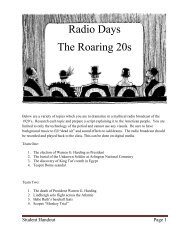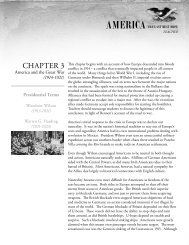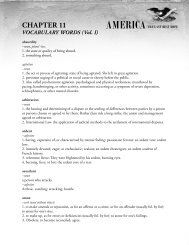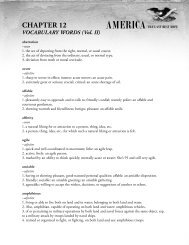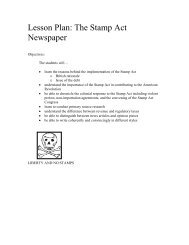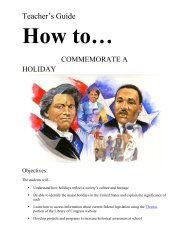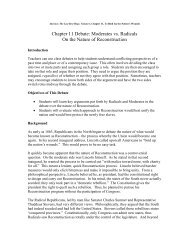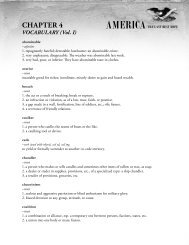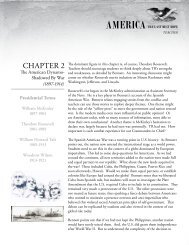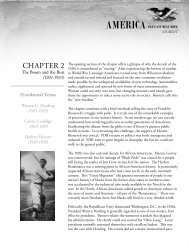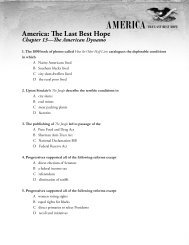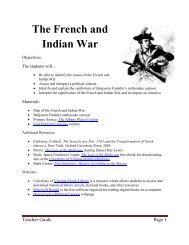Chapter 8 Debate: Resolved, John Brown was a ... - Last Best Hope
Chapter 8 Debate: Resolved, John Brown was a ... - Last Best Hope
Chapter 8 Debate: Resolved, John Brown was a ... - Last Best Hope
You also want an ePaper? Increase the reach of your titles
YUMPU automatically turns print PDFs into web optimized ePapers that Google loves.
America: The <strong>Last</strong> <strong>Best</strong> <strong>Hope</strong>, <strong>Chapter</strong> 8, The Rising StormIntroduction<strong>Chapter</strong> 8 <strong>Debate</strong>: <strong>Resolved</strong>, <strong>John</strong> <strong>Brown</strong> <strong>was</strong> a TerroristTeachers can use class debates to help students understand conflicting perspectives of apast time and place or of a contemporary issue. This often involves dividing the classinto two or more parts and assigning each group a role. Students are then encouraged totake on that role and argue their position. They need to argue the position they areassigned, regardless of whether or not they agree with that position. Sometimes, teachersmay encourage students to know both sides of the argument and have the two sidesswitch roles midway through the debate.Objectives of This <strong>Debate</strong>• Students will be able to describe actions taken by <strong>John</strong> <strong>Brown</strong> in Kansas in the1850s and at Harper’s Ferry in 1859.• Students will be able to discuss the meaning of the term “terrorist” and apply thatdefinition to the case of <strong>John</strong> <strong>Brown</strong>.Background<strong>John</strong> <strong>Brown</strong> <strong>was</strong> a figure that certainly helped spark the Civil War. He spent years on apersonal crusade to eliminate the evil system of slavery from the American landscape.He <strong>was</strong> an active participant in the 1850s Missouri-Kansas border conflict and his actionsthere were a large reason the crisis became known as “Bleeding Kansas.” But, of course,it <strong>was</strong> his 1859 raid on Harper’s Ferry, Virginia that made him a household name. On theoccasion of his execution for his role in that raid, views of him fell along sectional lines.Some in the North considered him a martyr to justice. Many southerners saw his actionsas a confirmation that the North had fallen under the sway of radical abolitionists, makingstaying in the Union impossible. People in the middle believed him to be insane.Historians have debated his legacy ever since.ProceduresThis debate can be done in one class period. The teacher should divide the class into twoparts, each side making arguments either for or against the resolution. Students should bereminded that they should stick to their role and argue passionately for their position,despite what they personally may believe. They should also be encouraged to base theirpoints on factual information, rather than opinion and emotion.Each side of the debate should research both their position AND the position of theiropponents. This is important in the event the teacher elects to have the sides changepositions. It also makes for a better debate because each side is better able to counterarguments of their opponents.
Students should be able to use America: The <strong>Last</strong> <strong>Best</strong> <strong>Hope</strong> to find dual perspectives onthese issues, but teachers will also need to provide background through short lectures orexplanations. Students can also do research on their own to find arguments to supporttheir point of view. Primary sources from the period can be particularly valuable as aside builds its case.The following chart represents basic points that should be covered by both sides.Teachers should not immediately give students these points. They might be offered toeach side after students have had time to research on their own, or they might be withhelduntil after the debate and used as a summary or to debrief the debate.A blank version of the chart is offered at the end of this debate. Students may use thisblank chart to take notes as they research their positions in the debate.When the debate takes place, arrange student desks or chairs with the two debate factionson opposite sides of the classroom facing each other. The teacher should serve as amoderator, beginning the proceedings, laying out the resolution, and calling on membersof each side in alternating order. If the debate begins to lag, the teacher may call a shortbreak and have each side “caucus” to rethink their positions and prepare responses toarguments made by the other side.
<strong>Resolved</strong>, <strong>John</strong> <strong>Brown</strong> <strong>was</strong> a TerroristAffirmativeNegative• He took the law into his own hands,both in Kansas and at Harper’sFerry.• The only just way to achievechange in our system is though thepolitical process.• Yes, there may be occasions thatcall for the breaking of laws, butwhen this happens, it should bedone peacefully – that is the natureof civil disobedience. <strong>Brown</strong> did soviolently.• He <strong>was</strong> clearly a terrorist atPottawatomie, Kansas. He and hismen killed five settlers there in coldblood. That is the very essence ofterrorism.• He <strong>was</strong> willing to kill innocentpeople to achieve his ends.• Terrorists seek to become martyrsto publicize their cause. That isexactly what he did at Harper’sFerry.• He knew his plan to launch a slaverevolt could not work. He alsoknew it would help spark a civilwar that would end slavery. He<strong>was</strong> willing to die to see this happen– very much like a terrorist.• <strong>Brown</strong> <strong>was</strong> not a terrorist, but afighter for a righteous cause.• He saw that slavery would neverend through peaceful means. Thereare times in life when violence isnecessary to eliminate evil.• In Kansas, his raid at Pottawatomie<strong>was</strong> in retaliation of the Missouriraid on Lawrence. This <strong>was</strong> war.• Also, while in Kansas, he showedgreat courage in crossing over intoMissouri to free slaves. He <strong>was</strong> afighter for justice.• Sometimes laws have to be broken,because they support evil. HenryDavid Thoreau knew this, Gandhiknew this, Martin Luther King, Jr.knew this.• Would slavery have ever endedwithout someone like <strong>John</strong> <strong>Brown</strong>to draw the nation’s attention to thisevil?• His plan at Harper’s Ferry <strong>was</strong> nottotally unreasonable. If slaves hadrisen up to join him, it might havesucceeded.
America: The <strong>Last</strong> <strong>Best</strong> <strong>Hope</strong>, <strong>Chapter</strong> 8, The Rising StormStudent <strong>Debate</strong> SheetName___________________Date____________________As your group researches their position on these issues, use the following table to recordyour views and prepare for the debate. You should research and prepare for both sides ofthis debate. As the debate progresses, make notes made by the opposing side that yourside did not anticipate.<strong>Resolved</strong>, <strong>John</strong> <strong>Brown</strong> <strong>was</strong> a TerroristAffirmativeNegative



